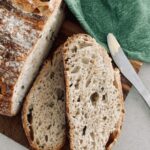
Pickle Sourdough Rye Bread Recipe
Pickle sourdough rye bread uses cucumber dill pickles to bring a flavor explosion to your sourdough bread!
Servings 1 Loaf
Calories 1840kcal
Equipment
- Mixing Bowl
- Banneton
- Dutch Oven
Ingredients
- 200 g Pickle Juice
- 170 g Water
- 50 g Active Sourdough Starter
- 350 g Bread Flour
- 50 g Whole Wheat Flour
- 100 g Rye Flour
- 3 g Salt
- 150 g Finely diced dill pickles
Instructions
- Autolyse / Premix: Weigh out your starter, water, pickle juice, flour and salt and mix altogether with the end of a wooden spoon. The dough will be fairly shaggy and only just brought together.Cover your bowl with cling film or a damp tea towel and let it sit for around 1 hour.
- Forming Up Your Dough: Work your way around the bowl, grabbing the dough from the outside, stretching it up and over itself until a smooth ball is formed. You shouldn't need more than about 20-25 folds to form the ball.Once the dough has formed into a smooth ball, pop the cling film back on and let it rest for 30 minutes.
- Stretch & Fold (Creating Structure): You need to add the diced dill pickles to your dough during the stretch and fold phase. It's very easy to do! Try to add the diced dill pickles around the second or third set of stretch and folds. So do your first set of stretch and folds with the dough as is and then add the pickles on the second (or third) set depending on how your dough is behaving. Try to do around 4 sets of stretch and folds with around 15 to 30 minutes between each set.It's up to you whether you want to do these in the bowl (less messy) or take your dough out onto your bench top and do it there. Do whatever you're more comfortable with.
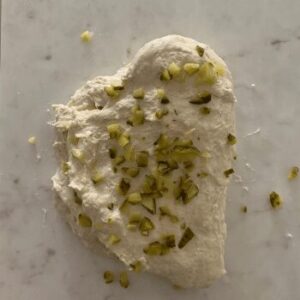
- Bulk Ferment: Once you've finished your stretch and folds, place the cling film or damp tea towel back over your dough and let it rest and ferment. The time this takes will depend on the temperature in your home (see recipe notes for more information).
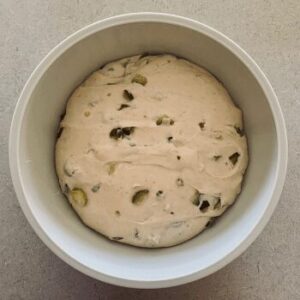
- Shaping Your Dough: Once your dough has finished its first ferment, it's time to give it some shape and surface tension. I think this recipe lends itself to a batard however it's completely up to you what shape you would like. Place your shaped sourdough into a banneton or other shaping container.
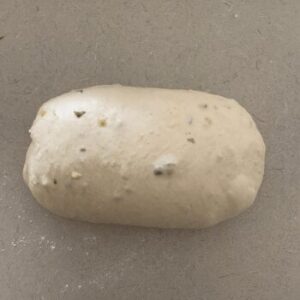
- Cold Ferment: Now your dough is in it's "shaping container" cover it loosely with a plastic bag or damp tea towel and place into the fridge. I use a large plastic bag to cover it - I just reuse it each time.Try to leave it in the fridge for a minimum 5 hours up to a maximum of around 36 hours. The longer you leave it the better your bread will be!
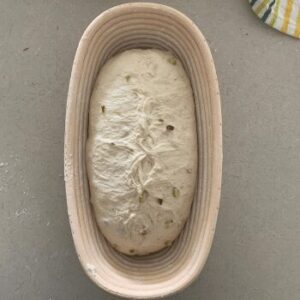
- Preparing to Bake: Once you're ready to bake your sourdough, you'll need to preheat your oven to 230C/450F. Place your Dutch Oven into the oven when you turn it on so it gets hot. Try to preheat for around 1 hour to ensure your oven is super hot - but you know your oven so just adjust this time if you need to.Leave your dough in the fridge until the very last minute - placing a cold dough into a hot oven will give you a great oven spring.
- Baking Your Pickle Sourdough: Now it's time to bake! When your oven is at temperature. Take your sourdough out of the fridge. Gently place it onto a piece of baking paper.Gently score your bread with a lame, clean razor blade or knife. Carefully take your dutch oven out of the oven. Place the sourdough into the pot using the baking paper as a handle. Put the lid on and place into the hot oven. If you want to you can spritz your dough with extra water before you put the lid on.BAKE TIME:30 Minutes with the lid on at 230C/450F plus10-15 Minutes with the lid off at 210C/410F
- Finishing Your Bake: When you remove your dough from the oven, carefully remove it from the dutch oven as soon as possible and place on a wire rack to cool.
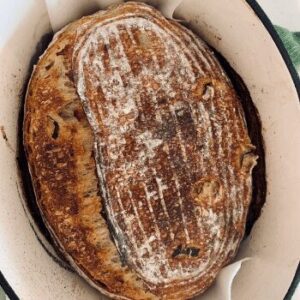
Notes
- Notes on Sourdough Starter
This recipe is based on you having an active starter that you have fed a few hours before starting your bake. For information on whether your starter is ready, go here. - Notes on Stretch & Folds
If you are going to do the stretch & folds on your bench top, spray your surface with water mist rather than using flour. This dough can be quite wet because of the rye and the moisture from the dill pickles, but it should still workable. - Notes on Bulk Fermentation:
If your home is warm then your dough will ferment a lot faster and could be done in as little as a few hours. If it's colder, it will take longer, possibly overnight. I would recommend that you try to do your first few bulk ferments during daylight hours so that you can watch your dough closely.
Once you're more familiar with the process - and the temperature of your home - you will be able to do overnight ferments.
You will know your dough is ready to move to the next stage when it has *just* doubled in size. It will be fairly wobbly and full of bubbles. You should be able to see large air bubbles under the surface of the dough.
You don't want to let it go any further than doubled as it will be over fermented. If you want to do an overnight ferment, but your home is warm, consider using a little less starter (ie 25g).
Less starter means your dough will take longer to ferment and you will reduce the risk of over fermenting your dough.
You'll find more information on these topics here:
When is my bulk ferment finished? What is the difference between cold ferment and bulk ferment? Why does the amount of starter matter? - Notes on Baking
If you're worried about the base of your bread burning, place a baking sheet on shelf underneath your Dutch Oven - it works! If you're worried about your bread not being cooked all the way through, turn the oven off and place your dough straight onto the oven rack.
Leave the door ajar and let your bread rest there for a few hours.
Remember not to cut into your loaf too soon - you'll need to let it cool for at least a few hours (4-6 is best).
Nutrition
Calories: 1840kcal | Carbohydrates: 380g | Protein: 59g | Fat: 9g | Saturated Fat: 1g | Sodium: 4181mg | Potassium: 906mg | Fiber: 26g | Sugar: 2g | Vitamin A: 12IU | Calcium: 99mg | Iron: 8mg